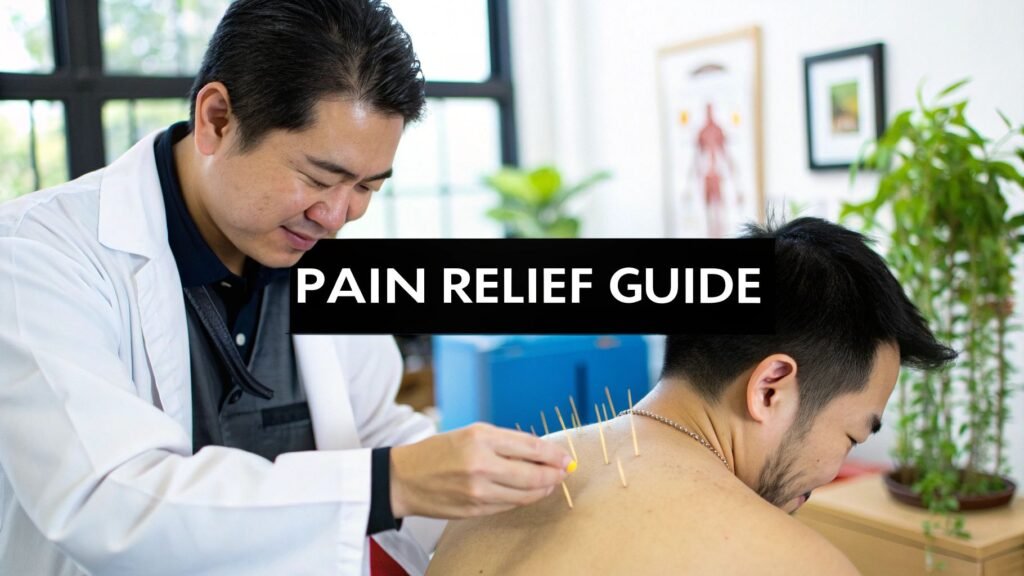If you're dealing with pain that just won't quit, you're not just looking for a temporary fix—you're looking for real, lasting relief. So, let's get straight to it: Yes, acupuncture is a powerful, evidence-backed treatment for chronic conditions like back pain, migraines, and arthritis. It's a non-drug option that has moved from an ancient practice to a key part of modern pain management.
Your Path to Lasting Pain Relief with Acupuncture
Living with chronic pain is exhausting. The cycle of doctor's appointments, medications that only do so much, and the constant, nagging discomfort can feel like a dead end. It’s a frustrating reality for millions, all searching for something that actually works instead of just masking the symptoms.
Acupuncture offers a fundamentally different approach. Rather than just trying to silence your body's pain signals, it gets to work on the underlying imbalances that might be causing the problem in the first place. This guide is designed to cut through the myths and give you an honest, clear-eyed look at how this therapy has earned its place as a credible tool in the fight against chronic pain.
A Global Solution to a Widespread Problem
Chronic pain isn’t just your struggle; it's a massive global health issue. In the United Kingdom alone, an estimated 43% of adults—that’s about 28 million people—live with some form of chronic pain. For people over 75, that number jumps to a staggering 62%.
Recognizing this, major health organizations, including the World Health Organization, are now recommending a more integrated approach. They’re encouraging strategies that blend conventional medicine with proven complementary therapies like acupuncture. You can dive deeper into the research on how national health systems are adopting these approaches to learn more.
What You Can Expect from This Guide
Think of this guide as your roadmap. We’ll explore how acupuncture works—from both traditional and modern scientific viewpoints—and break down which conditions it treats most effectively. We'll even walk you through what to expect during your very first session. Our goal is to give you the confidence that comes from truly understanding your options.
We believe that understanding your treatment is the first step toward reclaiming your quality of life. By the end of this guide, you’ll have a practical grasp of how acupuncture could fit into your personal pain management plan.
Before we dive into the details, here is a quick overview of what acupuncture for chronic pain involves.
Acupuncture for Chronic Pain At a Glance
This table summarizes the key aspects of using acupuncture for chronic pain management, providing a quick reference.
| Aspect | Description |
|---|---|
| Treatment Goal | To reduce pain, decrease inflammation, and improve overall function and well-being. |
| How It Works | Involves inserting thin needles into specific points to stimulate nerves, release endorphins, and regulate the body's natural healing processes. |
| Common Conditions | Effective for back pain, neck pain, osteoarthritis, headaches, migraines, and fibromyalgia. |
| Session Duration | A typical session lasts between 30 to 60 minutes. |
| Treatment Frequency | Initially, 1-2 sessions per week are common, with frequency decreasing as symptoms improve. |
| Sensation | You might feel a dull ache, tingling, or warmth at the needle sites, but it's generally not painful. |
| Effectiveness | Many patients report noticeable improvement within 4 to 6 sessions, though this can vary. |
This snapshot gives you the basics, but there's a lot more to the story. Let's start the journey to discover if acupuncture is the solution you’ve been searching for.
How Acupuncture Actually Works to Reduce Pain
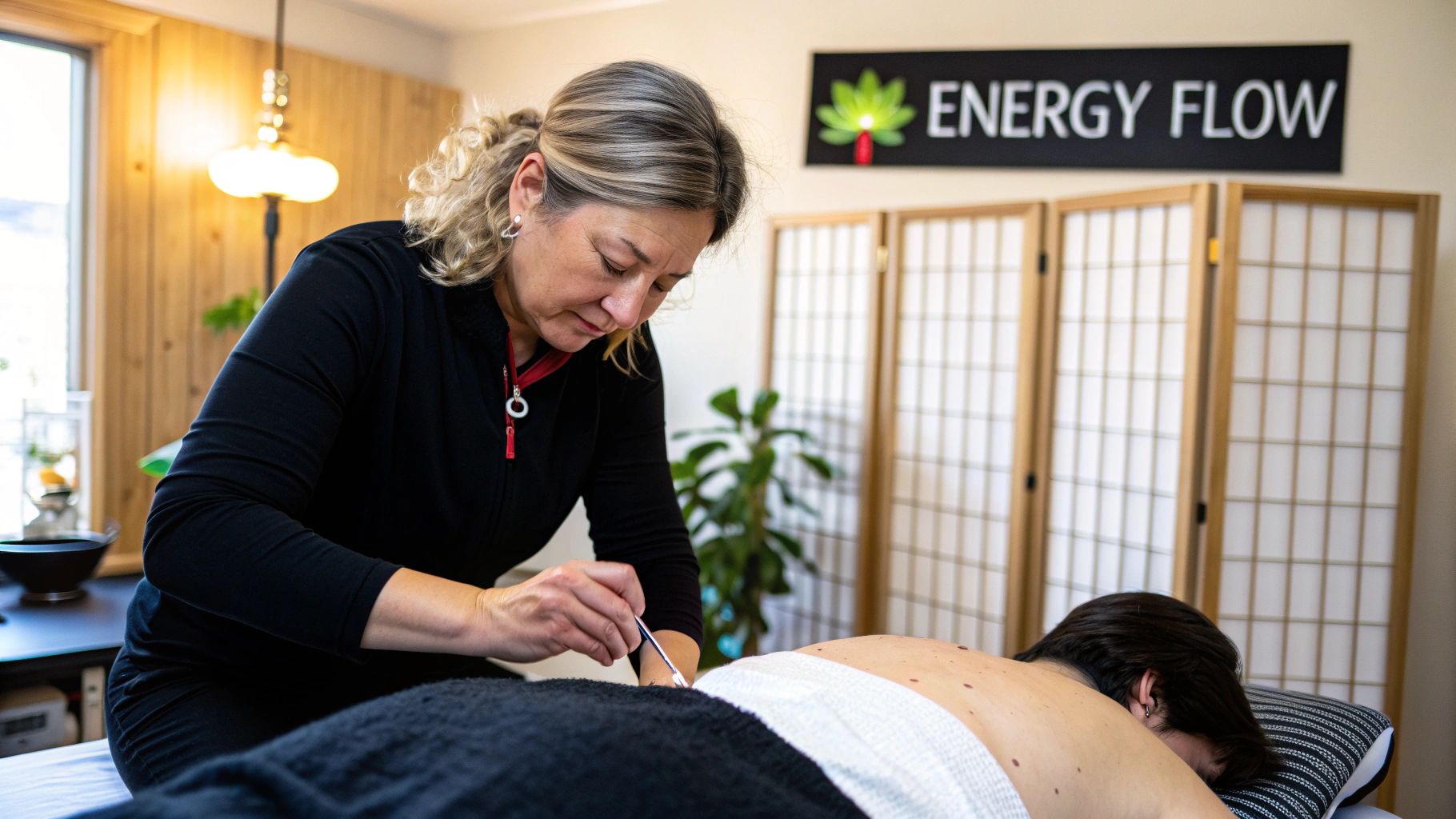
To really grasp how acupuncture helps with chronic pain, it's useful to look at it from two different but complementary angles: the ancient principles of Traditional Chinese Medicine (TCM) and the concrete findings of modern science. While they use different languages to describe what’s happening, both point to the same outcome—real, tangible pain relief.
In TCM, the body is viewed as an intricate landscape crisscrossed by energy pathways called meridians. A vital life force, known as Qi (pronounced "chee"), is meant to flow freely through these channels, much like water through a network of rivers. When you're healthy, this flow is smooth and unobstructed.
From this perspective, chronic pain is essentially a roadblock. It’s like a dam has been built in one of those rivers, disrupting the flow of Qi and causing a backup. This stagnation is what you experience as pain, stiffness, or inflammation. The acupuncturist’s job is to insert incredibly fine needles at precise points to help dismantle that "dam" and get the energy moving freely again.
Bridging Ancient Wisdom with Modern Science
The idea of Qi and meridians might sound a bit abstract, but modern science is increasingly providing a clear, physiological explanation for why this ancient practice gets results. When an acupuncture needle stimulates a point on your body, it's not some mystical event—it's neurobiology in action.
That tiny needle sends a signal up the nervous system to the brain and spinal cord. You can think of it as sending a high-priority alert to your body's central command. In response, the brain triggers a whole cascade of biochemical events aimed at restoring balance and dialing down pain.
This is where the old and new perspectives meet. The "blockages" that TCM practitioners talk about often correspond with what modern anatomy sees as clusters of nerves, trigger points, or areas of tight connective tissue.
The Release of Your Body's Natural Painkillers
One of the most powerful responses your body has to acupuncture is the release of endorphins. These are neurochemicals that act as the body’s own natural opioids. They dock onto the same receptors in your brain that prescription painkillers target, effectively turning down the volume on your pain signals.
But this isn't just about masking the pain temporarily. By prompting your body to produce its own pain-relieving chemistry, acupuncture helps you build a more sustainable, self-regulating system for managing discomfort. It’s a major reason why many people find that the relief from a session lasts for days or even weeks.
Research has shown that acupuncture promotes the secretion of pituitary endorphins and adrenal corticosteroids, substances that inhibit the area in the brain responsible for initiating pain and even nausea. This provides a clear biochemical basis for its therapeutic effects.
Beyond just endorphins, acupuncture works on several other fronts to tackle chronic pain:
- Regulating Neurotransmitters: It helps balance chemicals like serotonin and dopamine, which are crucial for mood, sleep, and how we perceive pain. Since chronic pain is so often intertwined with depression and anxiety, this can significantly improve your overall well-being.
- Reducing Inflammation: Studies confirm that acupuncture can calm the body's inflammatory response. By dialing down pro-inflammatory chemicals at a cellular level, it gets to the root cause of pain in conditions like arthritis or old injuries.
- Improving Blood Flow: The needle stimulation naturally increases local circulation. This brings a fresh supply of oxygen and nutrients to the painful area, which helps repair damaged tissue, flush away metabolic waste, and reduce swelling.
Ultimately, acupuncture is a way of communicating with your nervous system to kickstart its own powerful healing mechanisms. Whether you prefer to think of it as unblocking Qi or stimulating a neurochemical release, the goal—and the result—is the same: helping your body find its way back to balance and providing profound relief from chronic pain.
The Science Backing Acupuncture for Pain Management
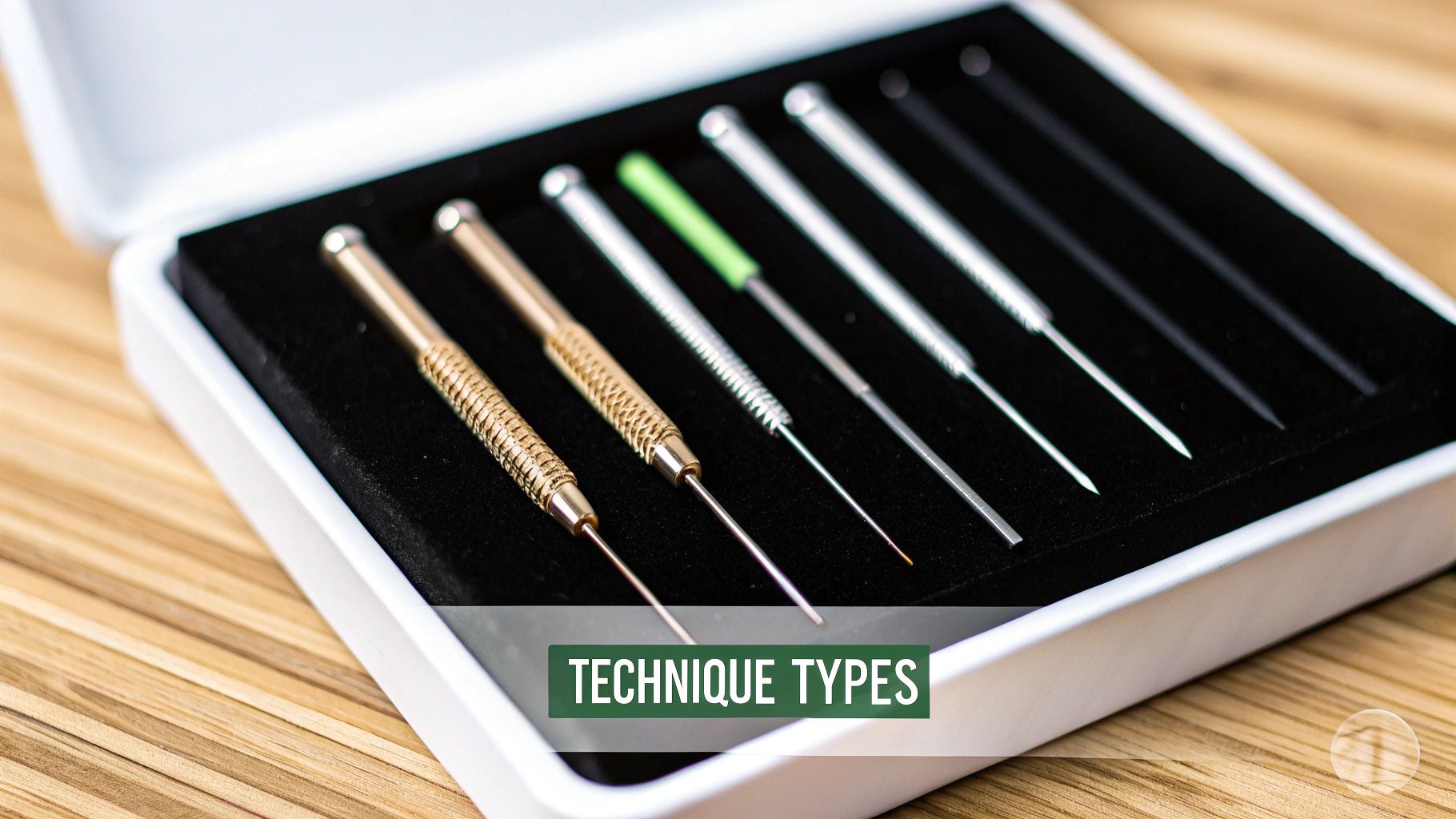
While the ancient principles of acupuncture have stood the test of time, its growing acceptance in modern medicine isn't based on tradition alone. It’s built on a solid, and rapidly expanding, foundation of scientific evidence. Over the last couple of decades, acupuncture has made the leap from a treatment often labeled "alternative" to a well-regarded, evidence-based therapy for a host of conditions—especially chronic pain.
This isn't about blind faith. It’s about rigorous scientific investigation. Prestigious medical institutions worldwide have poured resources into understanding not just if acupuncture works, but precisely how it triggers physiological changes in the body.
A Global Surge in Scientific Inquiry
The scientific community's focus on acupuncture for chronic pain is more than a passing trend; it's a profound shift. The number of research papers published on this topic has shot up by nearly tenfold in the last twenty years compared to the two decades before. This explosion in research signals a real acknowledgment of acupuncture's clinical value.
Leading this charge are research powerhouses like the United States and China, with strong collaborative efforts from countries like England and Germany. The overwhelming conclusion from this body of work is that acupuncture is effective for chronic pain. This has led to major systematic reviews and clinical guidelines officially recommending its use. You can see a fascinating visualization of this global effort in this knowledge mapping of international research.
This mountain of evidence has pushed the conversation forward, giving acupuncture a firm footing in mainstream pain management strategies.
Moving Beyond "Does It Work?"
Early studies often asked a simple question: Is acupuncture better than a placebo? Today, the science is far more sophisticated. We're now exploring the specific ways acupuncture influences both the body and the mind. It’s common for studies to now investigate its impact on conditions that are often tangled up with chronic pain, like stress, anxiety, and poor sleep.
For instance, clinical trials have shown that electroacupuncture can significantly ease symptoms of anxiety and depression in people who are also struggling with chronic physical pain. By calming the psychological distress that so often rides shotgun with persistent pain, acupuncture offers a more holistic form of relief.
A landmark study on cancer pain revealed that both electroacupuncture and auricular (ear) acupuncture were more effective at reducing chronic musculoskeletal pain than standard care, which included typical pain medications.
This gets to the heart of how acupuncture works. It doesn't just numb the sore spot; it influences the central nervous system to change your entire perception of pain and improve your overall sense of well-being.
Key Scientific Findings in Pain Management
The evidence supporting acupuncture isn't just broad—it's incredibly specific. Researchers have pinpointed several key areas where acupuncture delivers measurable relief for those living with chronic pain.
- Pain Signal Reduction: Study after study confirms that acupuncture can ease general cancer-related pain and musculoskeletal pain. It's now a recommended therapy for patients navigating these challenging symptoms.
- Targeted Relief for Joint Pain: For people with joint pain, especially from osteoarthritis or as a side effect of certain drugs, acupuncture has proven to be a powerful tool for relief.
- Improved Nerve Function: Research shows acupuncture can improve nerve signaling and quality of life for those with nerve-related pain, like the numbness and tingling of peripheral neuropathy.
The science is clear. Acupuncture has earned its place as a legitimate, effective, and evidence-backed treatment. It's a credible and valuable option for anyone searching for a lasting solution to chronic pain.
Which Chronic Conditions Does Acupuncture Help Most?
While acupuncture is a versatile therapy that can help with a whole host of health issues, it really shines when it comes to certain types of chronic pain. If you're trying to figure out if your specific condition is a good match for this treatment, the answer often comes down to the science. For some ailments, the research is so strong that acupuncture is now a go-to recommendation, either on its own or alongside other treatments.
You can think of it like this: just as a cardiologist is the expert you see for your heart, acupuncture has its own areas where it's proven to be a specialist. Let's dig into the conditions where acupuncture has shown the most consistent and powerful results for chronic pain, and I’ll explain how it works in each case.
Chronic Lower Back Pain
Lower back pain is one of the top reasons people walk into a doctor's office, and it also happens to be one of the most thoroughly researched areas for acupuncture. A practitioner will typically focus on points in the lower back, hips, and sometimes even the backs of the knees to help release tight muscles and get energy moving again.
From a modern medical perspective, these needles are stimulating nerves that send a message straight to the brain. This prompts the release of your body's natural painkillers—endorphins—and dials down inflammation in the lumbar area. It’s a one-two punch that provides immediate relief while also encouraging long-term healing by addressing the root causes, like muscular imbalances or poor circulation.
Osteoarthritis of the Knee
Osteoarthritis, especially in the knee, is a condition where cartilage wears down over time, causing pain, stiffness, and making it hard to get around. Acupuncture offers a fantastic, drug-free way to manage these symptoms. Treatment usually involves placing needles directly around the knee joint to zero in on local pain and inflammation.
By boosting blood flow to the joint, acupuncture can help reduce swelling and deliver much-needed nutrients to the surrounding tissues. This not only helps manage the pain of osteoarthritis but can also improve how the joint works, making daily activities like walking much less of a struggle.
Your practitioner might also use points on other parts of your body to tackle systemic inflammation, which is often a hidden contributor to arthritic conditions.
This chart breaks down data from major studies, comparing pain reduction between real acupuncture, sham (or placebo) acupuncture, and no treatment at all.
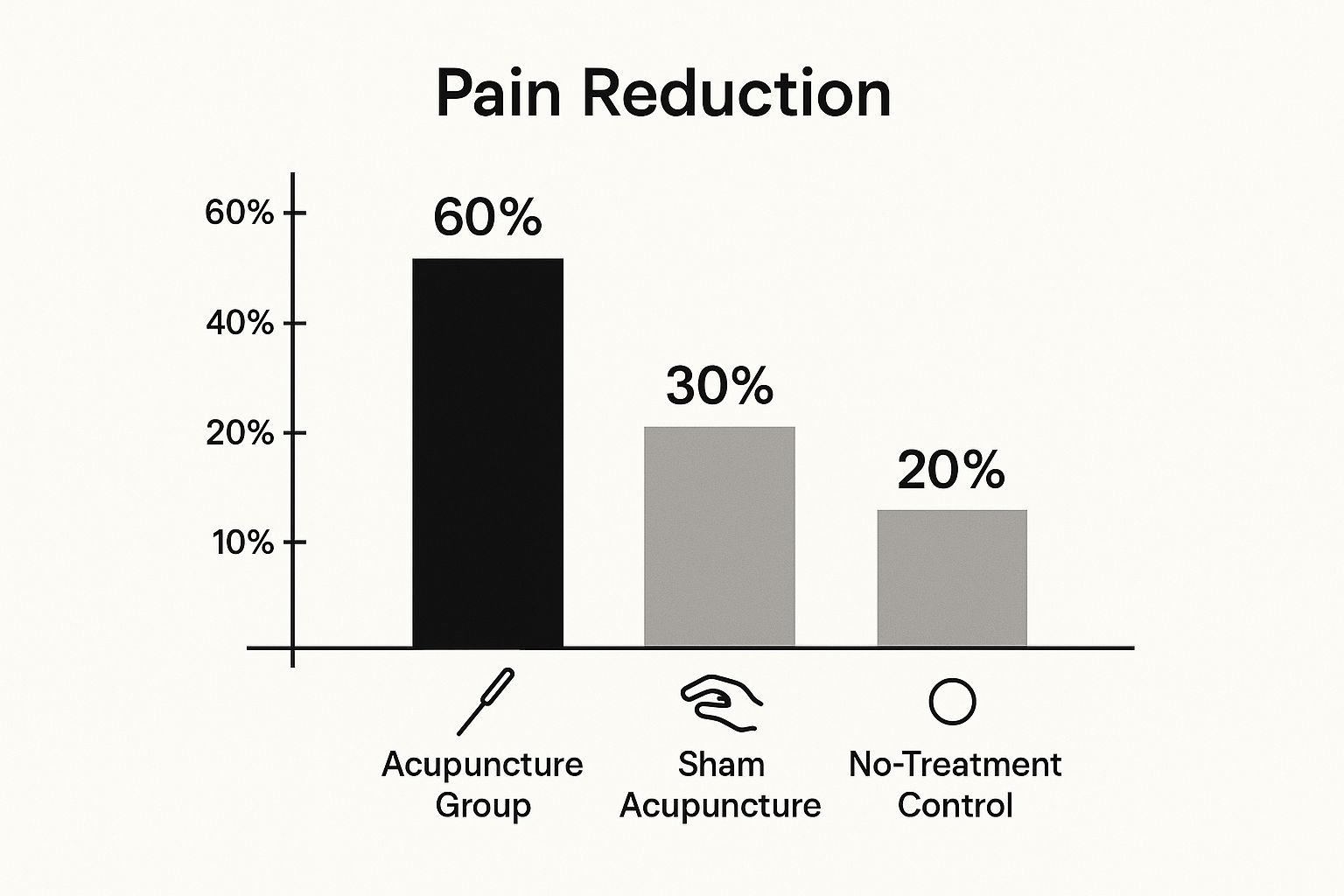
As you can see, genuine acupuncture consistently provides more significant relief than both placebo treatments and doing nothing, underscoring its specific therapeutic effects.
Fibromyalgia and Widespread Pain
Fibromyalgia is a tricky one. It’s a complex condition that brings on widespread musculoskeletal pain, deep fatigue, and tender spots all over the body. Because we don't fully understand what causes it, finding effective treatment can be a real challenge. This is where acupuncture has become a ray of hope, as it directly addresses how the central nervous system amplifies pain signals.
An acupuncturist will likely use a mix of local points right at the tender spots and other points further away that are known to calm the nervous system. The goal is to rebalance the body's pain-processing pathways. By influencing neurotransmitters like serotonin and dopamine, acupuncture can also help with the exhaustion, "fibro fog," and poor sleep that so often come with fibromyalgia.
Persistent Headaches and Migraines
For anyone who battles chronic headaches or migraines, acupuncture offers a proactive strategy to cut down on both how often they happen and how bad they are when they do. Instead of just reacting to a headache once it starts, treatment is all about prevention. An acupuncturist will often target points on the head, neck, shoulders, and upper back to release the underlying tension that can trigger these episodes.
The scientific backing for this is incredibly solid. One massive meta-analysis, which looked at data from nearly 18,000 patients, confirmed that acupuncture works significantly better than both sham treatments and no treatment for chronic back and neck pain, osteoarthritis, and chronic headaches. This level of research is what tells us that acupuncture’s benefits are due to real physiological changes, not just a placebo effect.
You can dive into the specifics by reviewing the in-depth analysis of chronic pain studies. It solidifies acupuncture's place as a scientifically validated option for long-term headache management.
To give you a clearer picture, here’s a quick breakdown of how acupuncture stacks up for some of the most common chronic pain conditions, based on the weight of scientific evidence.
Effectiveness of Acupuncture for Common Chronic Pain Conditions
| Chronic Pain Condition | Level of Evidence (Based on Major Studies) | Typical Area of Focus |
|---|---|---|
| Chronic Lower Back Pain | Very Strong: Consistently shown to be more effective than standard care. | Points on the lower back, hips, legs, and even feet. |
| Osteoarthritis (Knee) | Strong: Recommended by many orthopedic and rheumatology groups. | Needles placed around the affected knee joint. |
| Chronic Headaches/Migraines | Very Strong: Proven to reduce the frequency and intensity of attacks. | Points on the head, neck, shoulders, and hands. |
| Fibromyalgia | Moderate to Strong: Increasingly recognized as a valuable supportive therapy. | A mix of local tender points and points to calm the nervous system. |
| Neck Pain | Strong: Effective for chronic neck pain from various causes, like whiplash or posture. | Points on the neck, upper back, and arms. |
This table helps illustrate where the science is most robust, but remember, acupuncture's success always depends on the individual. It’s about finding what works for your body and your specific experience with pain.
What to Expect at Your First Acupuncture Session
Walking into any new treatment can feel a little intimidating, especially one that involves needles. I get it. But most of that anxiety comes from the unknown. So, let’s pull back the curtain on what actually happens during an acupuncture appointment for chronic pain, from the first conversation to that feeling of deep calm you'll have when you leave.
It might surprise you to learn that your session doesn't start with needles at all. It starts with a conversation. A good acupuncturist wants to understand your whole story, not just the one spot that hurts. This initial chat is crucial for getting to the root of your chronic pain.
Expect detailed questions about the pain itself—where it is, what it feels like, and what triggers it. But the inquiry won't stop there. Your practitioner will also ask about your sleep, digestion, stress levels, and overall energy. This holistic approach helps them connect the dots and see the bigger picture of your health, leading to a treatment plan that’s built just for you.
From the Welcome to the Treatment Table
After your initial talk, you'll be shown to a quiet, private room. You'll lie down on a comfortable, padded table, and your practitioner will make sure you're warm and relaxed. Many clinics use soft lighting or gentle music to create a truly serene environment.
Now for the part everyone wonders about: the needles. Let's be clear, these are nothing like the needles you get at a doctor's office for a shot. Acupuncture needles are incredibly thin—often as fine as a strand of hair.
Most people feel very little as they're inserted. You might feel a tiny, fleeting pinch, but what follows is a unique sensation called deqi. It’s often described as a dull ache, a gentle thrumming, or a spreading warmth. This is a good sign! It means your body's energy is being engaged and the therapeutic process has begun.
Your comfort is always the number one priority. A great practitioner will check in with you constantly. If you ever feel anything sharp or genuinely painful, speak up immediately.
Once the needles are set, it’s time to rest. Your acupuncturist will leave you to relax for about 15 to 30 minutes. Many people find this is the best part. They sink into a deeply meditative state or even drift off to sleep. This is your body's dedicated time to react to the treatment—calming the nervous system, releasing natural painkillers like endorphins, and dialing down inflammation.
After Your Session
When your rest time is over, the practitioner will return to remove the needles. This part is quick, totally painless, and you likely won't feel a thing.
Afterward, it’s common to feel incredibly calm and centered. Some people feel a quiet burst of energy, while others feel peacefully sleepy. Both are completely normal reactions.
To really maximize the benefits of your treatment, follow a few simple tips:
- Drink Water: Keep a water bottle handy. Staying hydrated helps your body continue the healing process.
- Keep it Low-Key: Try to avoid a major workout or a stressful board meeting right after your session. Give your body the space to integrate the effects.
- Observe: Notice how you feel. Pay attention to shifts in your pain, mood, and energy over the next day or two.
Knowing what’s coming makes all the difference. An appointment for acupuncture for chronic pain isn't a scary medical ordeal; it's a supportive therapy designed to work with your body, not against it. You can walk in feeling prepared and ready to heal.
How to Find a Qualified and Credentialed Acupuncturist
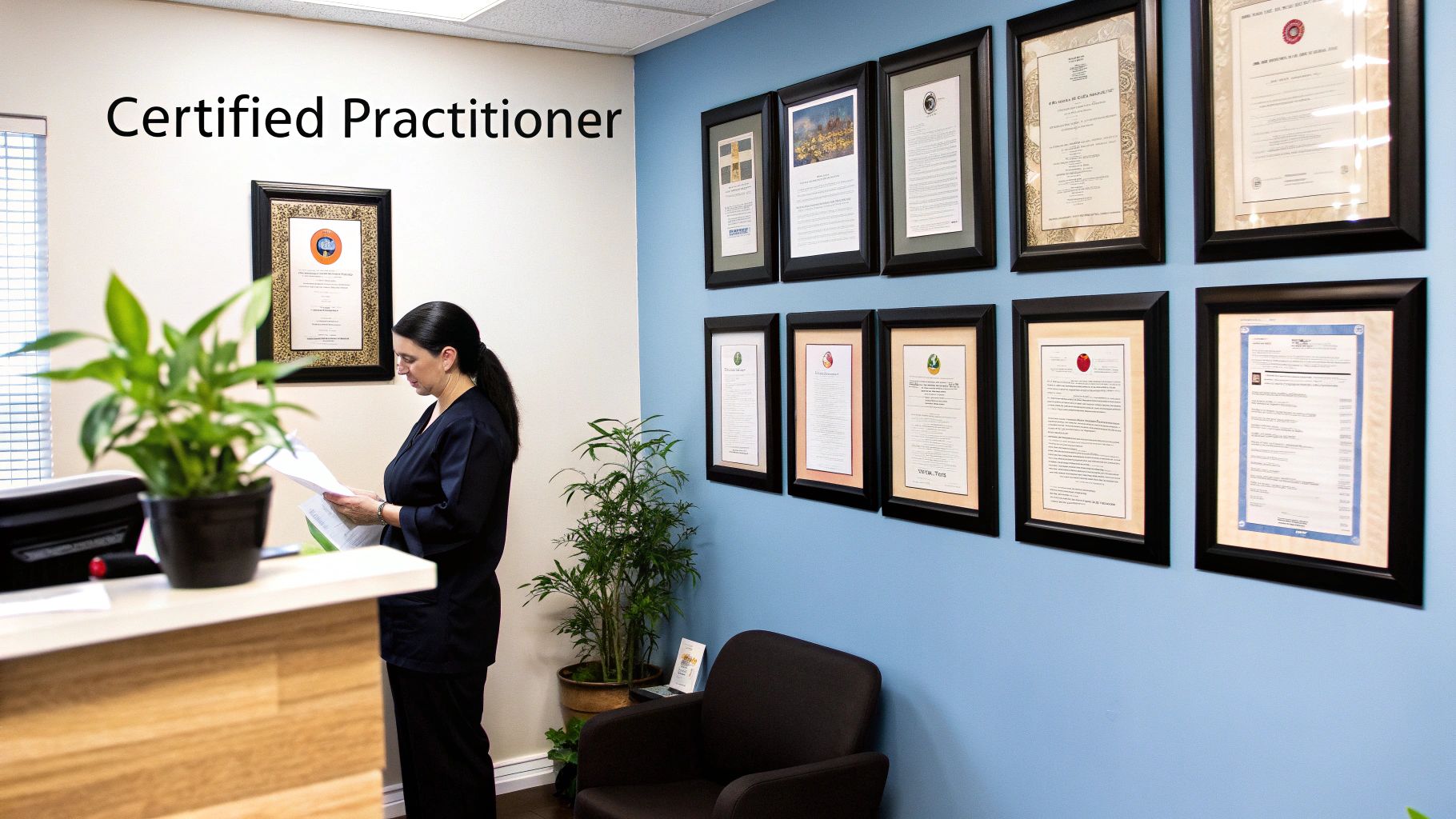
The success of your acupuncture treatment rests heavily on the expertise of the person holding the needles. Choosing the right practitioner isn't just about getting the best results—it's about ensuring your safety throughout the entire process. A true professional will take the time to conduct a thorough assessment and design a treatment plan specifically for your chronic pain.
Think of it this way: you wouldn't trust an unlicensed contractor to work on your home. The same logic applies here. Proper credentials are your assurance that the practitioner has undergone extensive training in anatomy, safe needling techniques, and professional standards of care.
Look for Key Credentials
When you start your search, the very first thing to check is the practitioner’s credentials. Those letters after their name aren't just alphabet soup; they represent years of dedicated study and national board certification.
- L.Ac. (Licensed Acupuncturist): This is the non-negotiable credential. It signifies that the practitioner is legally authorized to practice by their state's medical board, meeting strict educational and safety requirements.
- NCCAOM Certification: This certification from the National Certification Commission for Acupuncture and Oriental Medicine is the gold standard in the United States. It confirms the practitioner has passed rigorous board exams covering the full scope of the medicine.
These credentials tell you the acupuncturist has a solid foundation in both Traditional Chinese Medicine and modern biomedical science, a combination that’s essential for effectively addressing something as complex as chronic pain.
Finding a qualified professional is simpler than you might think. A great first step is to use the provider directory on the NCCAOM website. It’s a reliable tool for locating credentialed acupuncturists near you and building a shortlist of potential candidates.
Prepare Your Questions
Once you have a few names, treat the first interaction like an interview. Whether it's a quick phone call or a formal consultation, this is your chance to gauge if they're the right partner for your health journey.
Here are a few essential questions to get the conversation started:
- What is your experience with my specific condition? Be direct. Ask about their track record with chronic pain, whether it’s migraines, back pain, or fibromyalgia. A practitioner with focused experience is always a plus.
- What does a typical treatment plan look like? They should be able to outline a general plan, including the likely frequency and number of sessions needed to see progress for your condition.
- Do you accept my health insurance? Many clinics, like Eric Tsai Acupuncture & Herbs, can verify your benefits for you. It’s always smart to ask if they can check your coverage for acupuncture for chronic pain upfront.
- What is your treatment style? Get a feel for their approach. Do they integrate other modalities like cupping, herbal medicine, or electroacupuncture into their treatments?
- What are the costs per session? Make sure you have a clear picture of the fees, especially if you’ll be paying out-of-pocket.
Taking these simple steps empowers you to choose with confidence. You'll be able to find a trusted professional who can safely and effectively guide you on the path to lasting pain relief.
Common Questions About Acupuncture for Pain
As you explore different avenues for managing chronic pain, it's completely normal to have a list of questions. Getting straight answers is the first step toward feeling confident in your choice. Let's walk through some of the most common things people ask when considering acupuncture.
Most first-timers are shocked by how comfortable the whole process is. Acupuncture needles are incredibly fine—many are no thicker than a human hair. You'll barely feel them, and the sensation is nothing like getting a shot or having blood drawn.
What you'll likely notice instead is a unique, subtle feeling called deqi (pronounced "duh-chee"). People often describe it as a dull, gentle ache, a sense of warmth spreading, or a light tingle right around the needle. That feeling is a good thing! It’s a sign that the treatment is activating your body's natural healing pathways.
How Many Sessions Will I Need?
This is the classic "it depends" answer, because it really does. Your treatment plan is built around you—how long you've had the pain, how intense it is, and your overall health. Some people feel a shift after just one or two appointments.
For more stubborn, long-term conditions, a standard course of treatment usually starts with 6 to 12 sessions. We often schedule these once or twice a week to build momentum. As you start to feel better, we'll space the visits out. Your practitioner will map out a schedule that makes sense for you and your progress.
Think of it like starting a new workout routine. The first few sessions lay the groundwork. The appointments that follow build on that foundation to create lasting change. Consistency, especially in the beginning, is what really drives long-term relief.
Will My Insurance Cover Acupuncture?
This is a big, practical question, and the answer is getting better all the time. More and more insurance plans now cover acupuncture, particularly for well-documented conditions like chronic low back pain, neck pain, and migraines.
That said, every policy is different. The only way to know for sure is to check your specific benefits. You can call the number on the back of your insurance card, or you can ask the clinic you’re considering. Many, like ours, offer to verify your benefits for you, which takes the guesswork out of the equation.
Are There Any Risks or Side Effects?
Acupuncture is remarkably safe when it's done correctly. That means going to a state-licensed and nationally-certified acupuncturist who uses sterile, single-use needles. When those standards are met, the risk of any serious issues is extremely low.
The side effects you might encounter are usually minor and don't last long. These can include:
- A little bruising or a tiny drop of blood where a needle was.
- A feeling of being deeply relaxed or even a bit tired right after your session.
- A brief, temporary flare-up of your symptoms before they start to improve.
These reactions are typically seen as part of your body's healing process kicking into gear. The most important thing is to keep an open line of communication with your practitioner about what you're feeling so they can ensure you're always comfortable.
Are you ready to see if Eric Tsai Acupuncture & Herbs can help you find lasting relief from chronic pain? We combine traditional wisdom with modern understanding to create personalized treatment plans and can verify your insurance benefits for you. Take the next step by exploring your options at https://drerictsai.com.
Article created using Outrank

